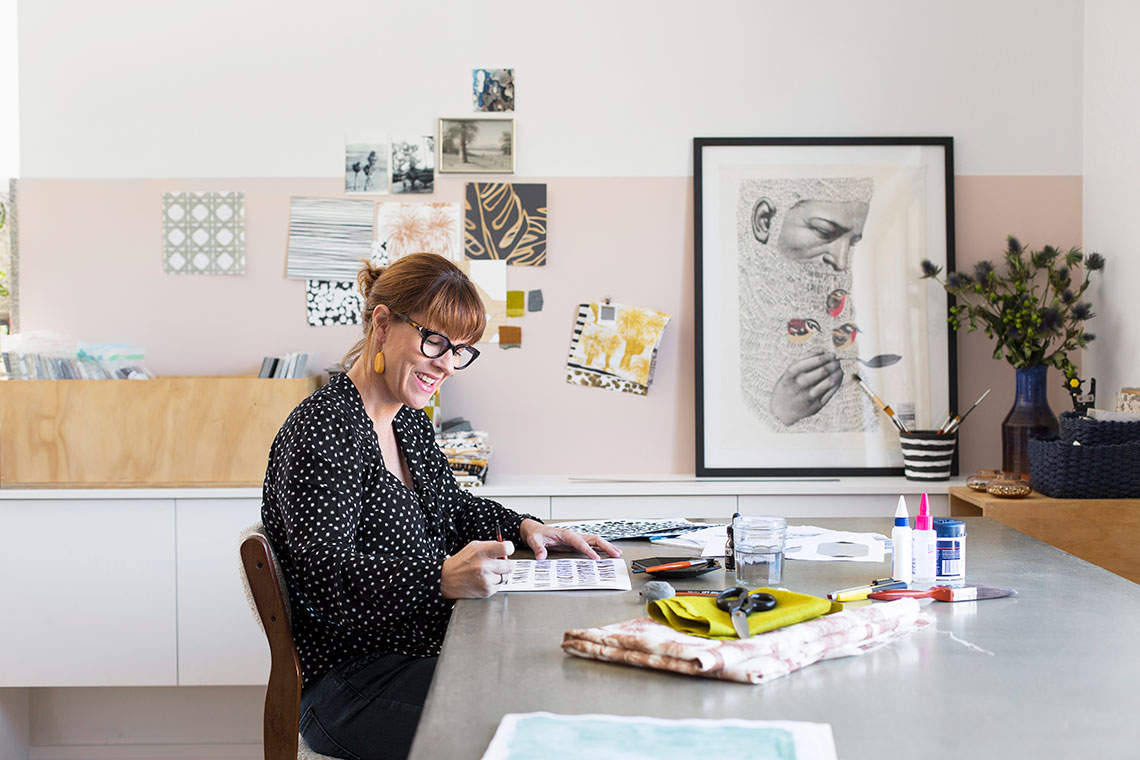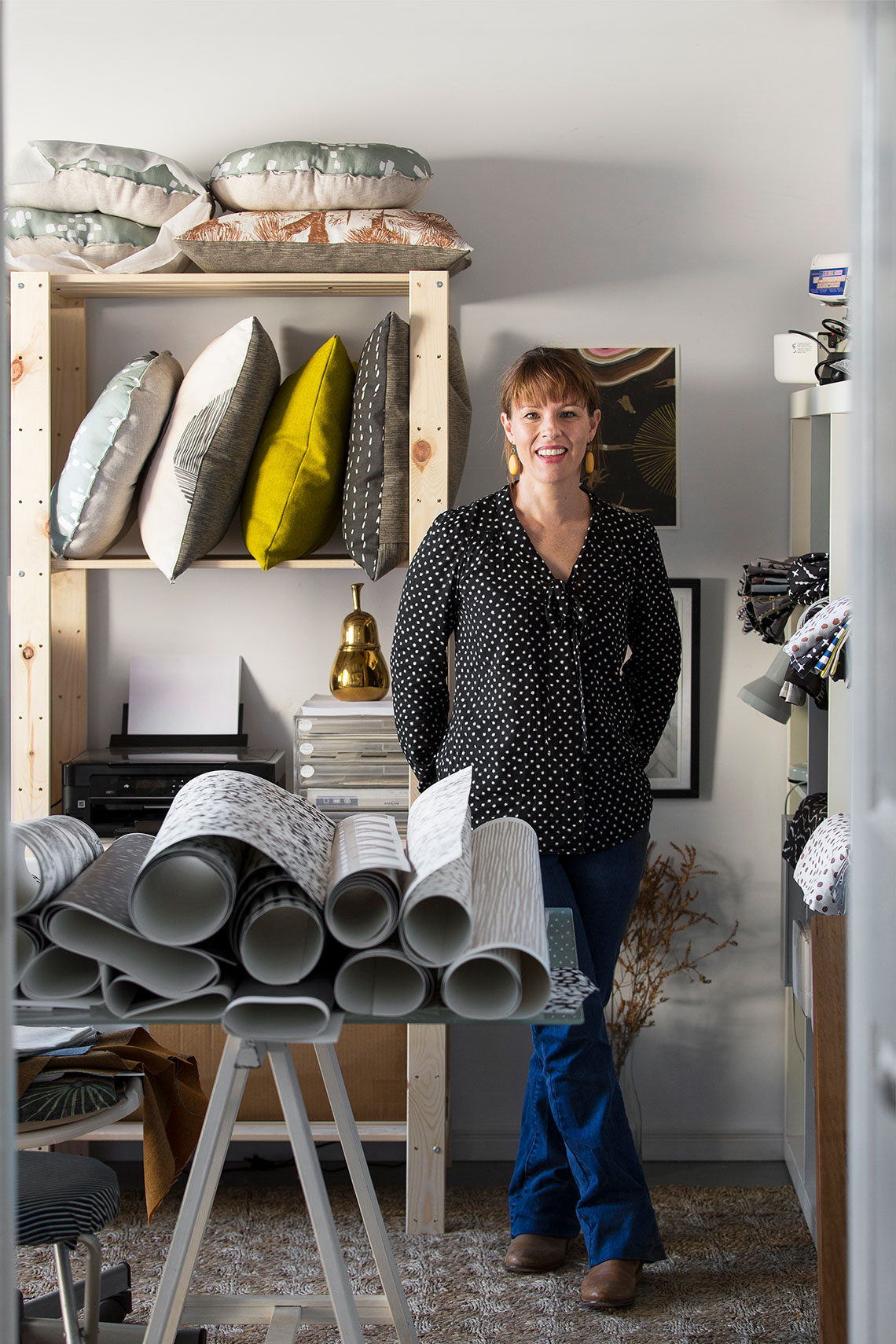I met Sara a couple of years ago when she was promoting her textile label These Walls. I immediately fell in love with her cushions (and trust me, I have seen a lot of cushions!). What I loved most about Sara’s work was it’s organic quality, you could visibly see Sara’s hand made details across her patterns, which in themselves were so unique.
Sara lives in Burleigh, on Queensland’s Gold Coast. Her home sits in the most perfect location, surrounded by iconic old Queensland homes just a short walk to Burleigh beach and popular local hang outs. Every time I see Sara she is beaming from ear to ear and her down to earth personality immediately puts you at ease. With a background in graphic design, Sara still brings an artistic nature to the computer. A self confessed recluse, Sara enjoys the quiet life at home with her family, where she can slip into her own creative world of pattern making.
Sara’s clock is available via online auction. To bid, click here.

When did you realise you were creative?
I realised I was creative when all my friends were hanging out at lunch time, just doing their thing and I was in the dark room developing photos, being just a creative nerd.
Can you describe the feeling that you get when you’re creating?
When I’m creating I kind of get lost into this vortex of time. I don’t even really know what’s going on around me sometimes. I just kind of get absolutely immersed. I have to keep my phone next to me so that I can keep track of where I need to be, if I need to be somewhere or someone’s calling, otherwise the whole world can just pass me by.

Where do you draw inspiration?
I draw inspiration from the world around me. The inspiration for one of my designs ‘Scallop Dots‘ came from glass paneling in my front door. I see patterns in nature and in man made architecture. I like to look around and keep my eyes open.
You have a lot of patterns in your work. When you see something do you need to get it down on paper straight away?
For my process when I’m developing a pattern, it usually simmers with me for a little while. I might see something and I kind of just note it mentally. If I see something visually I’ll do a screen capture and it just kind of gets logged away. Then when I get to actually sit down and really turn the laptop off, get the pens and paper out and get working, that’s when those ideas come together. I will sit down and I’ll work it out, whether it’s drawing or painting. I’ll then scan my work and then start to build the patterns, make sure that they’re repeating and looking good and pulling the colours all together.

What’s the most important part of your creative process?
I enjoy starting the initial artwork process as it actually goes really quickly. It can be done in just a matter of minutes or a few hours. But the most important part of the process is once I’ve got all my images and their scanned in my computer. Then I will just really play around with them to make sure that they’ve got the right balance, that the patterns are repeating and not only that but I start to work on some as stand alone pattern pieces. That’s all done in Photoshop on my Mac and I would say that’s where the most in depth part of my process is.
How do you know when a piece is finished?
It’s hard to explain knowing when something is done because you’re so ready to move onto the next step that you don’t even acknowledge it in some ways. You’re just drawing and then all of the sudden you’re like, all right, bang, let’s go. I walk down to the scanner and it’s such a satisfying part of the process, hearing that little scanner going.

Between the computer and illustration, what do you feel most comfortable with?
What comes most naturally for me is the drawing aspect. I’ve been illustrating for years. It’s just like coming home, getting out the paint brushes and the pencils. However the thing that I do get really excited about is turning them into the patterns. In the whole scheme of things, I haven’t been making patterns really for that long and I love it because it’s a bit of a challenge. I’m not really mathematically inclined so I have to really think about it. It’s not just total free-form.
What attracted you to patterns?
I received a few briefs from various clients looking for my illustration work in a pattern. I didn’t really seek it out, it came quite naturally. Once I started seeing the challenge involved in pattern making, I thought yes, I can absolutely see myself going in this direction. I had been illustrating really intensely detailed portraits for almost a decade so to have that change was really enticing to me.

How would you describe your style?
I would describe my style as pretty earthy, relaxed, slightly understated. I set out wanting to create designs that I would see working in my own house. If I didn’t want to put it on my couch or my wall, then no, I shouldn’t put it out there. That’s probably where that’s come from.
Is there something that not many people know about you?
Probably people don’t know much about me because I like to hide away in my little home studio. I don’t know…
I didn’t know you were a recluse!
Yes I am. I sometimes will do anything to avoid cameras, social functions and the like. I guess people might not know that about me.

Why did you say yes to this collaboration?
I don’t know why I said yes to this collaboration because I’m about 11 on the awkward metre! But no, I love working with the Hunting for George crew, you guys are cool. Any chance to kind of get involved, I couldn’t say no, that’s for sure.
Have you ever designed to a circle before?
No, I haven’t designed to a circle before. I’m more used to working on 2 dimensional objects. I come from a publishing background so print has pretty much been all the way for me and only just recently, textiles.

What has been a major influence in your work?
I find it really difficult to pin down specific influences. Something that always echoes through my head, is my brother who is an amazing fine artist – the type of artist where it just comes from within, but he never finishes a single piece. He said to me, “You can’t trace, that’s out the window.” But all my lecturers told me “If there’s a shortcut in the commercial world, you take it.” I’ve always just been torn between these two ideas.
What did you study?
I went to Curtin University in Western Australia. I’m from Perth originally. I studied, a major in Graphic Design and a minor in Illustration. So I have always merged art with design.

What was the inspiration behind your clock?
Originally I had this idea of creating a clock for moms. I was going to make it a 16 hour clock and add a few more hours in the day. But instead of making the ultimate mother clock I decided to make a clock that would make me happy to have in my own home. I incorporated some of my new prints. I just love the rust and earthy colours but I also wanted the hands to pop a little bit so that’s how it came to be. I was going to use wallpaper on there but then I thought it needed that little bit of texture – to give it a bit of something extra.
Your clock is the only one with fabric which is exciting. How important is that tactile nature of your work?
I think the surface and the way that it feels is all part of it. When the person comes in contact with the object, it just gives it that little something extra. That “Oh I love that” kind of feeling when they pick it up.
What type of person will be drawn to this clock?
The type of person that will be drawn to this clock, I would say, just has a really good taste in clocks. Someone looking for just a nice way to tell time.
Sara Hingle’s Clock for the Hunting Collective 2016.
Sara’s clock is made with printed fabric and acrylic paint. Sara’s clock is available via online auction. To bid, click here. Sara Hingle is a textile designer and artist from the Gold Coast, Queensland. With a background in graphic design, Sara brings an artistic and organic nature to her pattern making.
All photography by Martina Gemmola for Hunting for George







